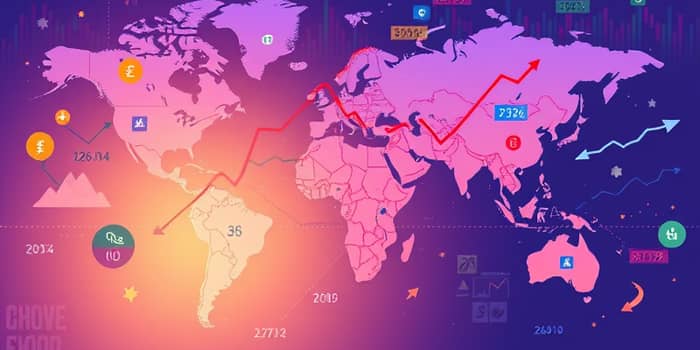
In an era defined by shifting markets and complex policy maneuvers, investors must understand how global trends shape their portfolios. The year 2025 presents unique challenges—and opportunities—for those who stay informed and agile.
Global economic growth for 2025 is now forecast at 2.3% to 2.9% this year, marking the slowest expansion since 2008 outside of recessions. Revised projections reflect widespread downgrades, with roughly 70% of economies seeing cuts. This deceleration follows an average growth rate in the 2020s that could become the slowest of any decade since the 1960s.
Several forces drive this sluggish pace. Developing markets that once surged at 6% annually in the 2000s are now inching below 4%. Meanwhile, developed nations grapple with mounting public expenditures—on infrastructure, defense, and pandemic recovery—feeding into elevated deficits.
Investors face significant trade policy uncertainty as tariffs and negotiations reshape global supply chains. Average import duties could climb from 2.5% to 14.5%, disproportionately affecting China, the European Union, Mexico, and Canada.
Heightened legal disputes and shifting trade agreements threaten to tip the global economy into recession. Trade growth, once 5% per year in the 2000s, now languishes below 3%. For portfolio managers, this environment demands careful risk assessment and diversification.
Headline inflation is easing to around 2.1% in 2025 and 2.0% in 2026 outside the U.S. Meanwhile, the Federal Reserve is expected to hold rates steady until early 2026. Other major central banks may cut rates sooner, potentially supporting equity markets and corporate bond issuance.
Bond investors should watch for shifts in yield curves as monetary policy diverges. Currency traders will likewise respond to interest rate differentials, altering the relative appeal of dollar, euro, and yen positions.
Governments worldwide continue to boost spending on essential infrastructure and defense, driving public deficits to highs not seen since German reunification in Europe and pushing U.S. borrowing costs upward.
This snapshot underscores the gravity of global headwinds. Investors must weigh growth prospects against borrowing costs, currency risk, and trade barriers.
Global capital flows now amount to roughly 15% of world GDP, compared to 2%–6% in the early 1980s and 1990s. This financial integration enhances liquidity but also exposes markets to rapid shifts in sentiment.
U.S. growth downgrades have placed downward pressure on the dollar, while optimism in the Eurozone lends strength to the euro. For international investors, currency allocation plays a pivotal role in total return.
While open markets foster opportunities, they also introduce heightened market volatility, particularly for emerging economies. Nations with weaker institutions face sudden stops in capital inflows and sharper downturns during global corrections.
Portfolio diversification now extends beyond traditional equity-bond mixes to include alternative assets, real estate, and niche private investments that may be less correlated with headline risks.
In this landscape, uncertainty remains the central theme. Investors should monitor policy developments, demographic shifts, and structural reforms that will shape growth trajectories over the next decade.
Despite the challenges, pockets of opportunity persist. Technology, renewable energy, and healthcare sectors in select markets may deliver superior returns. Likewise, infrastructure projects in developing countries offer long-term yield potential as governments prioritize growth-supporting spending.
By staying informed on ballooning government deficits and structural trends—like aging populations and labor force dynamics—investors can craft resilient, forward-looking portfolios. Embrace volatility as both a risk and a gateway to new openings in an interconnected global economy.
Ultimately, adapting to a slower, more complex growth environment requires discipline, diversified strategies, and a keen eye on policy shifts. Those who pivot effectively can not only protect their capital but position themselves for gains when headwinds ease and new growth cycles emerge.
References













